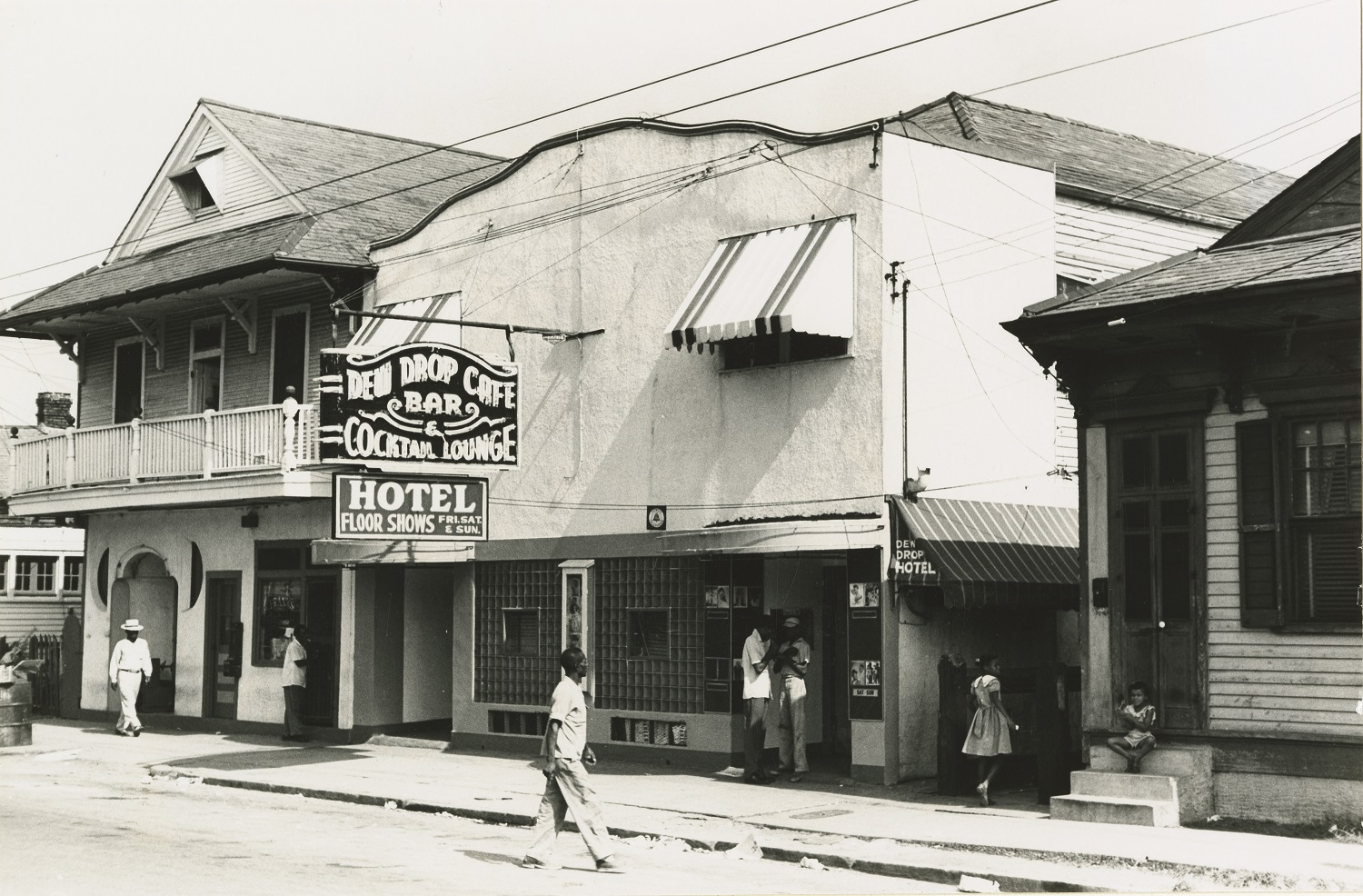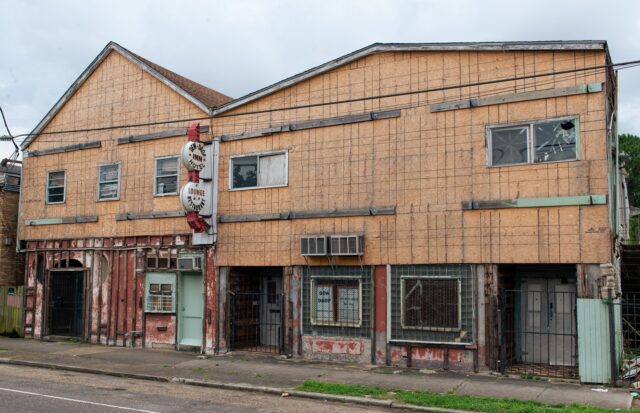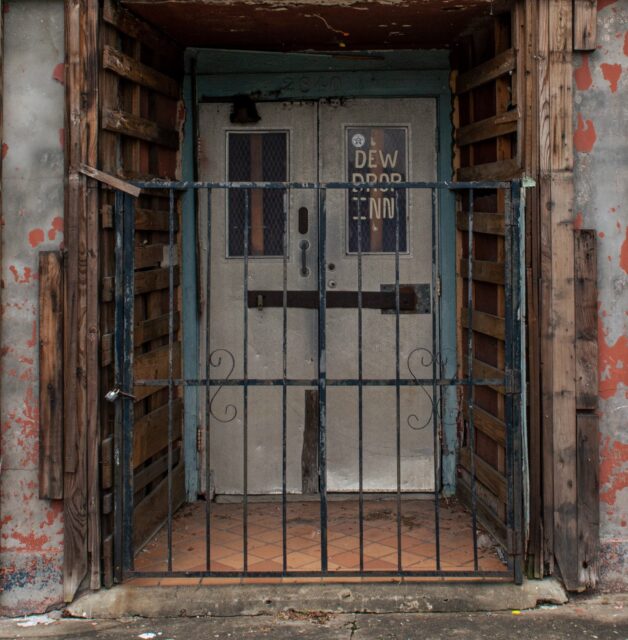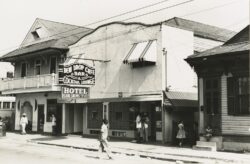Quarter Moons Rising
Reviving the South’s hottest night spot
Published: August 30, 2021
Last Updated: March 22, 2023

Ralston Crawford Collection of Jazz Photography, Howard-Tilton Memorial Library, Tulane University
Dew Drop’s exterior, 1953.
The New Orleans developer Curtis Doucette calls the Dew Drop his “passion project.” He bought the site in March from the family of its founder, Frank Painia, and plans to create something akin to what Painia himself created, beginning in 1939. That’s when Painia [pronounced PAN-yay] was cutting hair at 2836 LaSalle Street, between Washington and Louisiana Avenues. Painia bought that building in 1943, and then the one next door in 1945, adding a bar, restaurant, hotel, night club and on-site booking agency to his business empire. But what took nearly fifteen years to realize, Doucette hopes to restore in less than two, with a lounge, a restaurant, a music venue, seventeen hotel rooms, and a pool. He’s smitten with the Dew Drop’s potential. He’s also discovering its architectural past, which has been hidden until recently under a 1968 veneer of synthetic stone and siding. “This is the first time I’ve really fallen in love with a building,” Doucette said on LaSalle Street recently. “And I didn’t fall in love with the building until this stuff came off.”
Historic preservationists pinpoint the Dew Drop’s peak to circa 1953. That’s when the stout, two-story, conjoined buildings had a neon parapet and a fancy, streamline moderne sign suspended in front of its stucco façade. It looked like it could have been in Havana, or Port-au-Prince. Crescent windows in the shape of quarter moons accented the hotel entrance. Doucette found the moons and other vestiges of the compound’s former sparkle this year, when he briefly peeled back the 1968 overlay. He needed compelling evidence of the earlier incarnation of the Dew Drop to secure state and federal historic tax credits that make a renovation affordable. An early draft of Doucette’s application to add the Dew Drop Inn to the National Register of Historic places already has cleared the National Park Service. State preservationists must make their recommendation in December. No matter what happens, they’re in for a mighty good read.
“Still Roaring”
Even the most perfunctory account of the Dew Drop’s history includes a fair amount of dazzle. Duke Ellington! Little Richard! Ray Charles! Big Joe Turner! Dave Bartholomew! During segregation, these and scores of other regional and national acts made the place must-see entertainment. The Dew Drop was also a proving ground for local talent, including Earl King, Allen Toussaint, Tommy Ridgley, and Ellis Marsalis Jr., along with some, if not all, of the Neville brothers. Painia hired nearly every kind of performer—he liked exotic dancers, illusionists, ventriloquists, and comedians. But many of the musicians he booked at the Dew Drop—or who stayed there, or got their hair done there, or were just passing through—helped define American popular music in the twentieth century. And, by extension, so did LaSalle Street. The concentration of energy along that stretch of Central City coursed through nearly everyone. Rarely have musicians and audiences been so in sync.
“The Dew Drop was the best place in town,” Earl Palmer said in his 1999 memoir, Backbeat. The New Orleans–born drummer, who appears on the early recordings of Fats Domino and Little Richard, and on thousands more with artists from the Beach Boys to Sarah Vaughan, is widely seen as the man who introduced the explosive rhythm that launched rock ‘n’ roll. “It was our hang out, the club for blacks,” he said. “Most local musicians came in every night after work.”
“Me and my girlfriends, that was our favorite place,” retired state worker Hazel Picou said in May. In 1955, she was Hazel Thomas, nineteen, and living with her family across the street in the Magnolia housing development. “You talk about some beautiful days.”
“Four, five, six, daybreak in the morning, [musicians were] still roaring,” Palmer said. “It was a sit-down place, but it had a little area in the back for dancing.”
“You could leave there at 5 o’clock in the morning and nobody would touch you,” Picou said. “It was fantastic. Everybody was poor. But the projects didn’t have no crimes—just a little touch.”
The Dew Drop’s heyday coincided with the neighborhood’s. In the 1950s, LaSalle Street was teeming with businesses that catered to a rising constellation of Black families living in the Magnolia development. Carlisi’s Food Shop operated in the same block as the club, and Bynum’s Drug Store anchored the corner at Washington Avenue. A cart on LaSalle ran a brisk trade in hot tamales, and lettuce, tomato, and mayonnaise po-boys sold nearby for fifteen cents. What was then called Shakespeare Park teemed with children, and the masking Indians met there on Mardi Gras and St. Joseph’s Day. The Lincoln Theatre was walking distance, as was the old Holy Ghost Catholic Church, (now Katherine Drexel Catholic Church), which in those days never locked its doors. Nor did the Dew Drop. Its kitchen stayed open all night.
A Million–Dollar Plate
Paul Painia, Frank’s brother, ran the restaurant—yet another lucrative business on the compound—and he apparently made unforgettable fried chicken and red beans and rice. Taller than Frank, milder, and slimmer, he was the one in the white apron chopping up the seasoning, a Pall Mall cigarette hanging from his lips. “Paul was a different person. Friendlier than Frank,” said Walter “Wolfman” Washington, an award-winning New Orleans entertainer and former house-band guitarist. Washington also lived at the hotel in the early 1960s with a group called the Tick Tocks. “If cats were down on their luck, sometimes he’d give ’em a plate of red beans, or something.”
Paul’s red beans were the most popular item on the menu. They came with a smoked sausage link and two slices of buttered toast. “I’ve never had any like it anywhere else,” said Frank’s grandson, Kenneth Jackson. “He would cook ’em and he would use pigtails as part of the seasoning, and that would also be part of the plate.”
“Morning, noon, and night, that was the favorite,” Washington said. “He had a special way of mashing them while they were cooking. That’s where the creaminess comes from. I mostly ate at the Dew Drop.”
Over the course of his career, Ray Charles talked again and again about Paul’s food. He had lived at the Dew Drop in the 1950s, while on the precipice of stardom. “We played [the New Orleans] Jazz Fest in 1999 and . . . Ray came for dinner,” said Charles’s last drummer, Peter Burré, who lives Uptown. “I cooked him red beans and rice and he said, ‘I haven’t had a plate like this since the Dew Drop Inn.’” In 2003, Charles donated a million dollars to Dillard University in New Orleans “for the study of African American culture and foodways in the South.”

Curtis Doucette purchased the Dew Drop in March 2021 and plans to renovate the complex. Photo by Lavonte Lucas
Paul’s food and Frank’s services clearly meant more to their customers than what the Dew Drop was charging. Perhaps for musicians away from home it was a taste of family—of kindness—when they needed it. However people carried on in the hotel rooms, or in the shadows of the compound, which ranged more than twelve thousand square feet, there was also an affirming quality to the place. And for Black musicians, especially, the Dew Drop felt safe—a respite, maybe, from the lives they were living outside its doors.
“There wasn’t many [places like it], that’s for sure,” Washington said. “When I was out there [touring] it was segregated, so it was kind of weird. You couldn’t go to the front of restaurants. You had to go to the back, or to a window, to get food. So, you couldn’t eat as well. The way Frank had it, [the house band] got paid and everybody was happy with what they were doing. Especially the Black musicians. That was the first place they’d come to. They was always treated with respect.”
“Your life is that business”
And yet there’s a toll to be paid for running a place the size of the Dew Drop, or even a stand-alone night club. Heydays can’t last when there’s so much to do every day. By the mid-1960s, as the neighborhood’s fortunes tumbled, Frank fell ill, as did Paul, and their brother, Easton, who also worked on the compound. When they all died within six months in 1972, the business would never recover.
“Your life is that business and it wears on you after a while,” said Roland Doucette, a retired police officer and entrepreneur. He’s an uncle of the Dew Drop’s new owner, Curtis Doucette. In the 1970s, Roland and his brothers ran their own clubs in Central City called The Nite Cap and The Nite Cap II. The venues hosted weekly talent shows, sometimes with The Meters as the backing band. The Doucettes also featured top-drawer out-of-town acts, including David Ruffin, Joe Tex, The Manhattans, and The Chi-Lites. But their success proved costly in other ways. “You have to be there,” Roland said. “Nobody can watch your money better than you can. You have to watch your inventory, your bar sales. It will eat you up. We opened in 1971, when I was twenty-five years old. I got out of the business in my mid-thirties, but I felt like I was in my mid-seventies at that time.” The Night Cap and The Night Cap II eventually closed.
And yet Curtis Doucette is undeterred. Despite the Virginia creeper hanging through the Dew Drop’s open roof. Despite the grass growing underfoot on the old dance floor. He says he’s building on the lessons of the past. And if there are more stories about the property and what it means to Central City, he says he wants to hear them. Nearly all of the hotel rooms he envisions at the renovated Dew Drop will bear the name of someone associated with its history, including the civil rights lawyers who successfully defended Frank Painia against Jim Crow laws in the city. Doucette also plans to name a room The Nite Cap, after his uncles’ first club, one of the many in New Orleans that for a short time, at least, conjured some of the old Dew Drop’s glory.
Doucette is facing a groundswell of support from city leaders and nearly everyone else who hears his plans. People want to see a new moon rise over the Dew Drop. That may be why Cyril Neville keeps sending him so many encouraging texts. “It’s not hard to catch the vision,” Doucette said. After the renovation, he plans to put red and beans and rice on the restaurant’s menu, pronto.
Gwen Thompkins is the executive producer and host of public radio’s Music Inside Out, which showcases the unusually varied musical landscape of Louisiana. She has written for The New Yorker online, the Oxford American, NPR’s news magazines, and NPR Music. Since 2020, she’s been the New Orleans correspondent for WXPN’s World Café.

